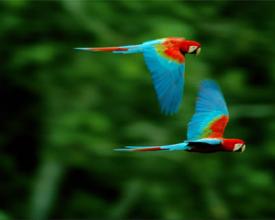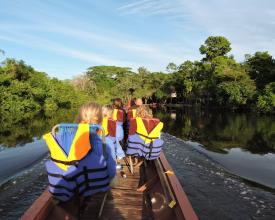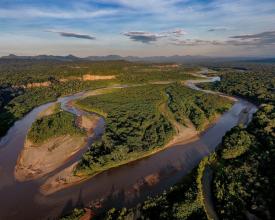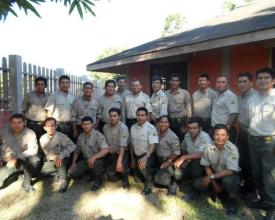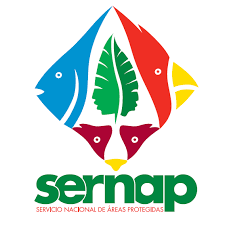
Two reasons why nature tourism in Madidi is an alternative to achieve conservation

The Madidi National Park and Integrated Management Natural Area is one of the most biodiverse protected areas on the planet, protecting a wide beauty and diversity of landscapes. It promotes nature tourism, generating great expectations for visitors and positioning it as one of the most important nature tourism destinations in the country.
These characteristics make the protected area a place to have a nature tourism experience, which is why the protected area's management regulates the area to provide adequate services to visitors, but also to comply with local standards and regulations in order to maintain the natural values. This activity is carried out in coordination with the local communities and businesses adjacent to the protected area.
From an IUCN Green List perspective, Madidi NP seeks to promote good governance and effective management, which is why tourism seeks to achieve successful conservation results.
Context
Challenges addressed
Tourism in the Amazonian zone of the Madidi National Park and Integrated Management Natural Area is one of the most developed sources of income and distribution of benefits in the region. During the COVID - 19 pandemic, it suffered strong impacts, reducing the tourist flow to less than 600 people per year. This panorama is changing, although the area has not yet recovered the number of international visitors, the flow of national visitors is maintained. In this context, the following challenges are posed:
- To recover the flow of tourists imminently diminished by the effects of COVID - 19.
- Search for sources of financing to facilitate local reorganization in order to resume tourism as a source of income.
- Promote local inter-institutional platforms that articulate tourism as an economic alternative and include the protected area as an element of analysis.
- Establish a post-pandemic strategy to build instruments, protocols and contingency plans.
Location
Process
Summary of the process
Nature conservation implies an integrated approach in which, although conservation objectives are varied and complex, productive actions such as tourism promote the participation and commitment of local stakeholders in conservation and generate economic benefits. To achieve this, a high level of institutional commitment and common and synergistic objectives are required. In addition, it is necessary to establish agreements and commitments to carry out these actions. In the area of tourism, it has taken a long time to consolidate actions and, to the extent possible, to have strategies and contingency plans that allow for dealing with changes and risks.
Building Blocks
Strategic alliances between the beneficiaries of tourism in Madidi
The Madidi National Park and Integrated Management Natural Area coordinates with the Vice-Ministry of Tourism, under the Ministry of Culture and Tourism, and local entities to prioritize this activity as a strategy for local and regional development, in addition to the recovery of the development vision and the use of natural, scenic and cultural values.
Enabling factors
- The institutions maintain a common vision based on nature conservation.
- Institutional conditions are in place to promote tourism as a local development strategy.
Lesson learned
- Strategic alliances in the area have been strengthened with a vision of tourism-driven development; this process is implemented with the participation of various stakeholders from different sectors, which has allowed for the planning of activities at different scales and scopes.
- The planning processes were established with a broad participation of the territorial actors, once they achieve a common objective, the context conditions were generated to work in a sectorial manner, in this case tourism, since with common objectives the search for different sources of funds is carried out and a common vision is established to have an impact in the medium and long term.
- Conservation objectives are very important when supporting development processes such as tourism. The main criterion to achieve conservation can be tourism, seen as a means to obtain tools and conditions establishing a context to conserve the protected area.
Application of resilience strategies in Madidi
Madidi understands that tourism is a sustainable activity that generates social, economic, and natural benefits for the protected area. Therefore, it is of utmost importance to apply planning processes to resume these activities. After the COVID-19 pandemic, many of the activities in the tourism sector were impacted and this caused a slowdown in tourism activities.
Enabling factors
- The level of organization is maintained and meets the goals and establishes priorities to continue promoting tourism in the area. These activities maintain a high level of participation by the local population.
- The government promotes a reorganization of tourism activities, promoting the participation of other productive sectors.
- It reduces the high personnel turnover that generates gaps and creates uncertainty in management.
Lesson learned
- The pandemic was a fortuitous problem that generated diverse impacts at different scales in the area. Although Madidi is willing and able to deal with complex problems, this extraordinary situation taught us to have a Plan B as a recovery measure, which requires great efforts and regrouping capacity, and these actions are based on an adaptive model of territorial management that allows us to manage sensitive but also complex aspects.
Impacts
Tourism in Madidi represents for the communities a development alternative based on the passive use of natural values, through the implementation of activities that can increase direct and indirect income from services, strengthen social participation and governance, and improve tourism services with respect to competitiveness, are the key elements pursued by the IUCN Green List of protected and conserved areas, reflected in its Management Plan but also in the indicators GL-V1.1-2.1.3-BO, GL-V1.1-3.3.2-BO and GL-V1.1-2.4.2-BO of the Green List Standard.
The main impacts of tourism activity identified are:
- At least 6000 tourists visit Madidi per year, in a constant flow from 2001 - 2019, it represents benefits to local populations in direct economic income to those who provide services and those who provide materials and inputs.
- Tourism contributes more than $170,000 per year to the management of the protected area. Many of these resources are redistributed to the local territorial management entities, but also to strengthen the protected area's management.
- Tourism promotes local and external investment by improving local services. In turn, there is an impact on infrastructure, education and the local governance system.
Beneficiaries
- Direct beneficiaries who provide services (local tour operators made up of local and indigenous inhabitants),
- Indirect beneficiaries, such as transporters, restaurants and producers who provide inputs and associated services.
Sustainable Development Goals
Story
Madidi Integrated Management Natural Area National Park (ANMI Madidi NP) is a protected area of Bolivia's national system of protected areas, created in 1997 through Supreme Decree 24123. It is located in the northern part of the department of La Paz - Bolivia. It covers an area of 1,895,750 hectares and is one of the largest protected areas in the country. It also has a wide altitudinal range that promotes the permanence of diverse species (6000 to 180 masl). The actions carried out within this protected area are complex because it borders multiple zones: to the west is Peru and Bahuaja Sonene NP, to the east is the Pilón Lajas Biosphere Reserve, to the south is the Apolobamba protected area, and to the north is the northern Amazon and Tacana territory. Madidi IMNA is one of the most biodiverse protected areas in the world and is divided into two categories: National Park corresponding to IUCN category "II" and Integrated Management Natural Area corresponding to IUCN category "VI".
The protected area is home to different social actors that plan their activities through their Territorial Integral Development Plans (PTDI), as well as indigenous territories such as Tacana, San José de Uchupiamonas, Lecos, Esse Ejas that claim the sustainable use of nature through their Life Plans, the presence of indigenous peoples in voluntary isolation such as the Toromonas, and the existence of peasant communities that develop their subsistence and extractive activities through the use of natural resources.
The over-positioning of uses in Madidi IMNA is very complex. There are road construction projects and even dams that threaten the area. These types of problems, and the size and logistics required by Madidi, demand that productive activities be measured and planned with the different authorities and sectors due to this multi-scalarity, in order to ensure the park's conservation. This is the reason why Madidi IMNA management has a very broad relationship with tourism, as it allows for multi-scale work, the involvement of diverse stakeholders and the elaboration of strategic actions integrated into several sectors.
It should be noted that Madidi IMNA NP is in the process of applying for the Green List, which is why it is trying to comply with the Green List Standard and undergo the evaluation processes carried out by EAGL-Bolivia.

